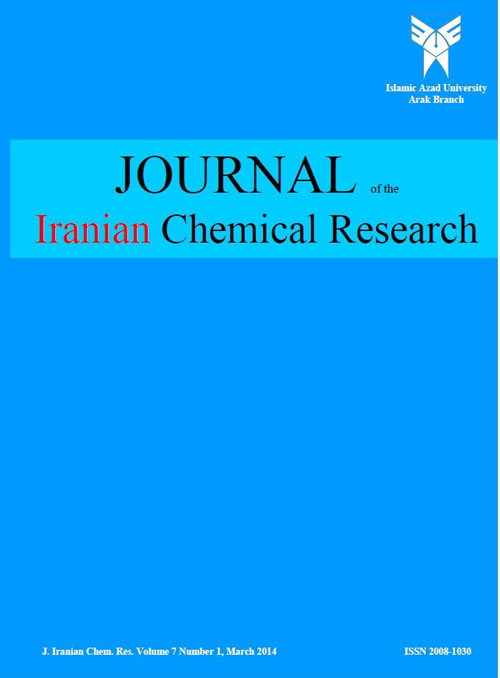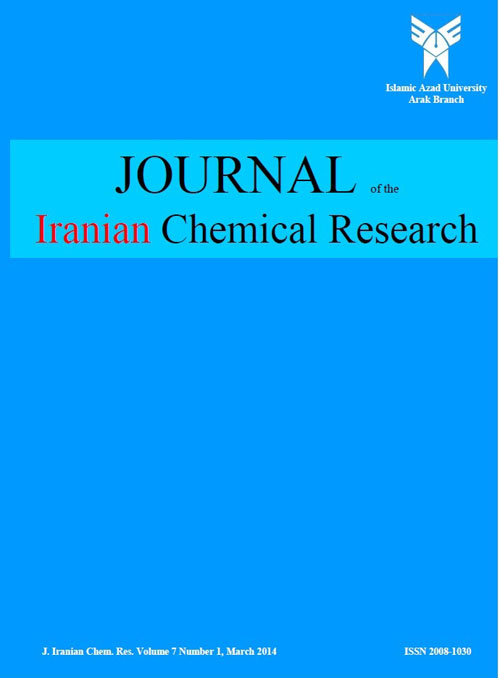فهرست مطالب

Journal of the Iranian Chemical Research
Volume:4 Issue: 3, Summer 2011
- تاریخ انتشار: 1390/06/30
- تعداد عناوین: 8
-
Pages 127-134The extraction of Gadolinium (Gd) from perchlorate and nitrate media in 1,2-dichloroethane (C2H4Cl2), carbon tetrachloride (CCl4) and chloroform (CHCl3) by mixtures of 2- thenoyltrifluoroacetone (HTTA) and a crown ether benzo-15-crown-5 (B15C5) is investigated.
The composition of the extracted species is determined as Gd(TTA)3.nB15C5 (n=1 in nitrate medium and n=2 in perchlorate medium). The values of the equilibrium constant KT,S and βT,S are calculated. The influence of the water medium and the polarity of organic diluents on the extraction process are discussed.Keywords: Lanthanoids, Thenoyltrifluoroacetone, Benzo, 15, crown, 5, Synergistic extraction -
Pages 135-139An efficient protocol for the selective oxidation of primary alcohols to aldehydes with H5IO6/V2O5 in ionic liquid [bmpy][PF6] has been developed. High yields of the products, mild reaction conditions and simple experimental procedure make this protocol complementary to the existing methods. The catalyst can be reused for several times without obvious loss of the catalytic activity.Keywords: oxidation, Primary alcohol, Aldehyde, Ionic liquid, catalyst
-
Pages 141-151An efficient protocol for the selective oxidation of primary alcohols to aldehydes with H5IO6/V2O5 in ionic liquid [bmpy][PF6] has been developed. High yields of the products, mild reaction conditions and simple experimental procedure make this protocol complementary to the existing methods. The catalyst can be reused for several times without obvious loss of the catalytic activity.Keywords: DPASV, As(III), Phenylpiperazine dithiocarbamate, Water, biological samples
-
Pages 153-164In this work a rapid and selective procedure for separation and preconcentration of lead (Pb2) before determination by electrothermal atomic absorption spectrometry (ETAAS) was developed. The procedure is based on the electrodeposition on a graphite probe modified with palladium. The lead was deposited from acetate buffer solution at pH 5.5. Various parameters, such as pH of solutions, deposition potential, buffer concentration, stirrer speed, time of deposition and temperature program, were optimized. After optimization of the conditions, detection limit 17 ng L1 by 3 σ, and enrichment factor 61 were achieved for 2 min electrodeposition time and improved as deposition time was increased. Linearity of calibration was kept between 0.05-0.50 μg L1 with a correlation coefficient of 0.9979 and suitable precision, R.S.D. % = 5.1 (n = 8). Samples were digested completely in a closed microwave digestion system using only perchloric acid, and interference owing to various cations was also investigated. The procedure was successfully applied to determine the presence of lead in rice, radish, okra, onion and water samples.Keywords: lead, Palladium, Electrodeposition, Preconcentration, Microwave digestion
-
Pages 165-175The degradation of poly (vinyl pyrrolidone) (PVP) by means of ultrasound irradiation and its combination with heterogenous photocatalysis (TiO2 nanoparticles) was investigated. Emphasis was given on the effect of additive on degradation rate constants. 24 kHz of ultrasound irradiation was provided by a sonicator, while an ultraviolet source of 30 W was used for UV irradiation. To increase the efficiency of degradation process, degradation system was combined with TiO2 nanoparticles (0.1-0.6 g L-1) in the presence of UV irradiation. Sonophotocatalytic process led to complete PVP degradation in 150 min with the rate increasing with increasing catalyst loading. Sonophotocatalysis in the presence of nanoparticles was always faster than the respective individual processes. A synergistic effect between ultrasound and ultraviolet irradiation in the presence of TiO2 nanoparticles was suggested. The average molecular weight of ultrasonicated PVPs was determined by measurements of intrinsic viscosity of samples.Keywords: Poly (vinyl pyrrolidone), Ultrasonic degradation, Viscosity, Molecular weight
-
Pages 177-185In the present work, an adsorptive stripping voltammetric method using a hanging mercury drop electrode (HMDE) was described in order to determine the ultra trace of thiosemicarbazide in different real samples. The method is based on accumulation of thiosemicarbazide on mercury electrode. The potential was scanned to the negative direction and the differential pulse stripping voltammograms were recorded. The instrumental and chemical parameters were optimized. The optimized conditions were obtained in pH of 10.0, accumulation potential of 0.00 mV, accumulation time of 60 s, scan rate of 80 mV s-1 and pulse height of 50 mV. The relationship between the peak current versus concentration was linear over the range of 0.50-100.00 ng mL-1. The limits of detection were 0.03 ng mL-1 and the relative standard deviation at 5.00 and 50.00 ng mL-1 of thiosemicarbazide ion were obtained 2.1 and 1.7%, respectively (n = 8).Keywords: Thiosemicarbazide, Adsorptive stripping voltammetry, Determination, Real sample
-
Pages 187-198Supercritical water oxidation has attracted attention of many researchers ever since the idea has emerged about three decades ago as a promising technique in the waste management industry. Providing more details about the behavior of a supercritical water oxidation system under various operating conditions and extending available data can greatly assist more accurate and reliable design of such systems. In this study, oxidation of phenol in supercritical water has been modeled as a plug flow reactor. The variations of main system parameters such as temperature and waste concentration along the reactor have been calculated. The numerical model predictions have been compared with available experiments and good agreement has been obtained for steady state operation conditions. In addition, the responses of the numerical model to some unsteady events, such as sudden increases of mass flow rate or fluid inlet temperature have been examined. These situations may possibly occur due to malfunction of various components of the system. It has been shown that the design temperature of the reactor with usual consideration of the safety factors supports the probable range of sudden alterations.Keywords: Supercritical water, oxidation, Phenol destruction, Reactor modeling, Nonstationary
-
Pages 199-206A Synthesis of doped ceria by combustion method is performed. Two types of fuel such as urea and glycine is used to investigate the effect of fuel reactivity and reaction rate on the morphology of the resulted powders. Thermo gravimetric analysis is carried out by (TG/DTA, Rigaku Thermalplus TG 8120) to study the exoendo temperature of as-received powder. The crystalline phases are identified by X-ray diffraction analysis (XRD). The average crystallite size, D, is estimated by using the Scherrer formula about 40nm. The calculated lattice parameter is 5.44Å. A FT-IR study is carried out on the obtained gel and reveals that a Glycine-Metal complex is formed in alkaline conditions which help in preventing metal ions selective precipitation and in maintaining the compositional homogeneity of the resulted powder. Finally, the effect of pH value, in the primary solution, and fuel type on the powder characteristics such as lattice parameter and morphologies are described.Keywords: Solid Oxide Fuel Cell, Nano Ceria, Combustion method, pH value


